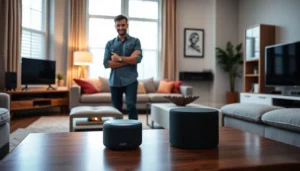Table of Contents
ToggleImagine walking into your home and controlling everything with a simple wave of your hand. No more fumbling for remotes or shouting at smart assistants that just don’t get it. Gesture control is revolutionizing the way people interact with their living spaces, making it not just smart but downright magical.
Overview of Gesture Control Home
Gesture control technology revolutionizes home automation by enabling intuitive interactions between users and devices. Users simply wave their hands or make specific motions to manage devices like lights, thermostats, and entertainment systems. This technology applies sensors that detect and interpret these gestures, streamlining the user experience.
Significant benefits accompany gesture control systems. They enhance accessibility for individuals with mobility challenges. Users equipped with gesture control can navigate their homes without needing physical remotes or speakers. The technology also reduces dependency on devices, fostering a more immersive environment.
Various industries are implementing gesture control in unique ways. Smart home manufacturers incorporate it into security systems, enabling users to monitor their homes with ease. Additionally, companies design gesture-controlled appliances, allowing consumers to adjust settings without touching switches or buttons.
Integration between devices plays a crucial role in maximizing the potential of gesture control. Seamless connectivity ensures users can operate multiple smart home devices simultaneously. Manufacturers often focus on compatibility to create a comprehensive ecosystem that responds to gestures cohesively.
As innovation progresses, gesture control technologies continue evolving. Enhanced sensors and machine learning algorithms improve gesture recognition accuracy. This advancement leads to more sophisticated applications, resulting in an increasingly mesmerizing smart home experience.
Investments in gesture control technology signal a significant trend in home automation. The growing demand for smart home systems encourages manufacturers to explore gesture-based solutions further. Homeowners enjoy a rich interaction landscape that simplifies daily tasks while elevating comfort and convenience.
Benefits of Gesture Control Technology

Gesture control technology offers numerous advantages that enhance everyday living. It streamlines interactions within smart homes, making the experience more user-friendly and efficient.
Enhanced User Experience
Enhanced user experience stems from intuitive interactions. Users accomplish tasks with simple hand movements, which creates a seamless environment. Customization becomes possible as gestures can be tailored to individual preferences, making control over devices straightforward. Efficiency remains a key benefit; no remote or voice commands are required, reducing the time spent navigating devices. Users feel empowered with this technology, enjoying the convenience of managing lighting, entertainment, and climate with fluid motions. Comfort increases as well, with effortless transitions between tasks, elevating overall satisfaction in smart home environments.
Accessibility Features
Accessibility features play a vital role in expanding gesture control’s appeal. Individuals with mobility challenges experience newfound independence thanks to gesture-based interactions, which eliminate the need for physical remotes. This technology fosters inclusivity, allowing everyone to engage with their living spaces effortlessly. Simple gestures replace complex tasks, making it easier for those who struggle with traditional controls. Enhanced navigation through gestures creates an environment where individuals can easily interact with devices. Customizable settings offer additional assistance, ensuring that everyone benefits from smart home automation.
Types of Gesture Control Systems
Gesture control systems can be categorized into two main types: hardware options and software solutions. Each contributes significantly to the effectiveness of home automation.
Hardware Options
Gesture control hardware involves a range of sensors and devices specifically designed to detect hand movements. Leap Motion sensors track finger movements with high precision, enabling users to interact seamlessly. Infrared sensors serve as another option, providing basic motion detection ideal for simple gesture recognition. Cameras equipped with depth sensing technology can interpret gestures more accurately over a wider range. Other devices like smartwatches can also incorporate gesture controls, offering wearable solutions for convenient device management. Each of these hardware options enhances the user experience and broadens the scope of gesture control applications.
Software Solutions
Gesture control software plays a critical role in interpreting and executing user commands derived from movements. Leading software platforms utilize machine learning algorithms to enhance gesture recognition accuracy. Open-source platforms invite customization, allowing developers to create tailored gesture commands that suit individual needs. Various applications integrate gesture controls for specific functionalities, like media playback or lighting adjustments. Mobile apps can sync with home automation systems, enabling users to control devices with gestures from their smartphones. Such software solutions amplify the capabilities of gesture control systems, making interactions more intuitive and efficient.
Popular Gesture Control Devices for Home Use
Gesture control devices enhance the smart home experience, providing seamless interaction options. A range of products is available that simplify device management.
Smart TVs and Media Systems
Smart TVs increasingly utilize gesture control to enhance viewing experiences. Users can adjust volume and switch channels with simple hand movements. Gesture controls enable effortless navigation through streaming services, making content discovery smoother and quicker. Some models come equipped with built-in cameras that recognize specific gestures. Brands like LG and Samsung lead the way, incorporating gesture recognition into their latest TV models. Furthermore, these systems are designed to work alongside voice assistants for multimodal control, improving accessibility for all users.
Smart Home Hubs and Assistants
Smart home hubs play a crucial role in integrating gesture control across devices. These hubs often support gestures for controlling lights, thermostats, and appliances. Users interact through simple motions, making adjustments without the need for remotes or apps. Leading products such as Amazon Echo Show and Google Nest Hub provide gesture control functionalities. These devices harness advanced sensors to recognize movements, allowing users to manage home environments intuitively. Additionally, compatibility with various smart home devices fosters a cohesive smart ecosystem, simplifying user interactions and increasing overall efficiency.
Future of Gesture Control in Smart Homes
Gesture control technology continues to advance, driving innovations that shape smart home experiences. Enhanced sensors and machine learning algorithms improve recognition accuracy, leading to more responsive systems. As demand for smart home solutions rises, investments in gesture control expand, creating a diverse interaction landscape.
Future devices may rely on advanced gesture control, allowing users to manage multiple systems simultaneously. Smart televisions will likely integrate gesture recognition alongside voice interfaces, enriching user interaction. Voice assistants may also evolve, enabling seamless command execution through hand movements.
Healthcare applications are emerging, particularly for those with mobility challenges. Gesture control fosters inclusivity, allowing individuals to interact with their homes effortlessly. Smart devices will prioritize accessibility, ensuring everyone benefits from enhanced home automation.
Integration of gesture controls with IoT (Internet of Things) presents exciting possibilities. Homeowners could customize gestures to manage specific functions, such as adjusting temperature or activating security systems. Enhanced interoperability between devices can strengthen this integration, creating a more connected living environment.
Leading technology companies continue to innovate within this space. Manufacturers exploring gesture control solutions include LG and Samsung, which are striving to enhance user experiences. More products are being developed that incorporate gesture technology, streamlining interactions with smart home setups.
The future also looks bright for gesture-enabled appliances. Users may adjust settings or navigate functionalities through intuitive movements, eliminating the need for touchscreens. Such advancements could redefine how households manage daily tasks, promoting efficiency and ease.
As solutions evolve, the adoption of gesture control will likely expand across various industries. Commercial spaces could also implement similar technologies, improving customer engagement and operational efficiency. Smart home technology is set to revolutionize our interactions with living environments, enriching lifestyles comprehensively.
Gesture control technology is reshaping how people interact with their homes. By enabling intuitive management of devices through simple hand movements, it creates a more engaging and efficient living environment. This innovation not only enhances user experience but also promotes accessibility for those with mobility challenges.
As advancements continue, gesture control systems are becoming increasingly sophisticated, integrating seamlessly with various smart home devices. The potential for customized interactions and improved connectivity is driving interest among homeowners and industry leaders alike.
With the rise of smart home solutions, gesture control is poised to redefine daily living, making homes smarter and interactions more effortless. The future holds exciting possibilities as this technology evolves, promising a more connected and user-friendly experience for everyone.




